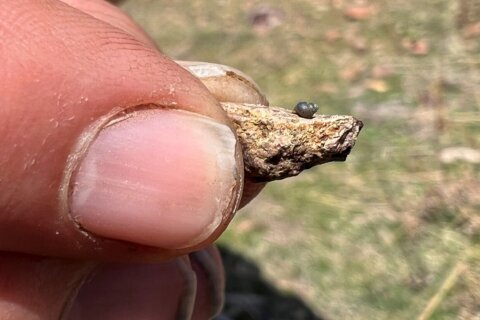GRAND COUNTY, Colorado (AP) — Somewhere on a remote mountainside in Colorado’s Rockies, a latch flipped on a crate and a wolf bounded out, heading toward the tree line. Then it stopped short.
For a moment, the young female looked back at it’s audience of roughly 45 people who stared on in reverential silence. Then she disappeared into the forest.
She was one of five gray wolves Wildlife officials released in a remote part of Colorado’s Rocky Mountains on Monday to kick off a voter-approved reintroduction program that was embraced in the state’s mostly Democratic urban corridor but staunchly opposed in conservative rural areas where ranchers worry about attacks on livestock.
The wolves were set free from crates in a Grand County location that state officials kept undisclosed to protect the predators.
It marked the start of the most ambitious wolf reintroduction effort in the U.S. in almost three decades and a sharp departure from aggressive efforts by Republican-led states to cull wolf packs. A judge on Friday night had denied a request from the state’s cattle industry for a temporary delay to the release.
The group watched as the first two wolves — 1-year-old male and female siblings with gray fur — were set free. The male bolted up the golden grass, running partially sideways to keep an eye on everyone behind, then turning left into the trees.
The crowd watched in silence, then some hugged each other and low murmurs started up.
When the latch on the second crate flipped, the wolf didn’t budge. Everyone waited as Colorado Gov. Jared Polis peeked into the cage.
After roughly 30 seconds, those around the crates stepped back, giving the wolf space. The female slowly rose then bounded up a snowy divot in the dirt road, looking back before disappearing into an aspen grove.
Wolves “have larger-than-life places in human imagination, in the stories we all grew up with and tell each other,” said Polis. “To see them in their natural habitat, and turn around look curiously at us … is really, really a special moment that I will treasure for my entire life.”
The other three wolves released were another pair of 1-year-old male and female siblings, as well a 2-year-old male. The wolves were all caught in Oregon on Sunday.
When the final crate opened, the 2-year-old male with a black coat immediately darted out, making a sharp right past onlookers and dashing into the trees. He didn’t look back once.
When it all ended, a small round of applause broke out.
Colorado officials anticipate releasing 30 to 50 wolves within the next five years in hopes the program starts to fill in one of the last remaining major gaps in the western U.S. for the species. Gray wolves historically ranged from northern Canada to the desert southwest.
The carnivores’ planned release in Colorado, voted for in a 2020 ballot measure, has sharpened divides between rural and urban residents. City and suburb dwellers largely voted to reintroduce the apex predators into the rural areas where prey can include livestock that help drive local economies and big game such as elk that are prized by hunters.
The reintroduction, starting with the release of up to 10 wolves in coming months, emerged as a political wedge issue when GOP-dominated Wyoming, Idaho and Montana refused to share their wolves for the effort. Colorado officials ultimately turned to another Democratic state — Oregon — to secure wolves.
Excited wildlife advocates have started a wolf-naming contest, but ranchers in the Rocky Mountains where the releases will occur are anxious. They’ve seen glimpses of what the future could hold as a handful of wolves that wandered down from Wyoming over the past two years killed livestock.
The fear is such attacks will worsen, adding to a spate of perceived assaults on western Colorado’s rural communities as the state’s liberal leaders embrace clean energy and tourism, eclipsing economic mainstays such as fossil fuel extraction and agriculture.
To allay livestock industry fears, ranchers who lose livestock or herding and guard animals to wolf attacks will be paid fair market value, up to $15,000 per animal.
Hunting groups also have raised concerns that wolves will reduce the size of elk herds and other big game animals that the predators eat.
Meanwhile, Colorado residents who backed the reintroduction are going to have to get used to wildlife agents killing wolves that prey on livestock.
Some wolves were already killed when they crossed from Colorado into Wyoming, which has a “predatory” zone for wolves covering most of the state in which they can be shot on sight.
Joanna Lambert, professor of wildlife ecology and conservation biology at the University of Colorado at Boulder, said she lost her breath when she saw the wolves gallop into the woods on Monday.
For years, Lambert and wolf advocates have been working to get wolf “paws on the ground” and “all the sudden, it happened.”
“This is a moment of rewilding,” Lambert said, “of doing something to stave off the biodiversity extinction crisis we are living in.”
Copyright © 2025 The Associated Press. All rights reserved. This material may not be published, broadcast, written or redistributed.







